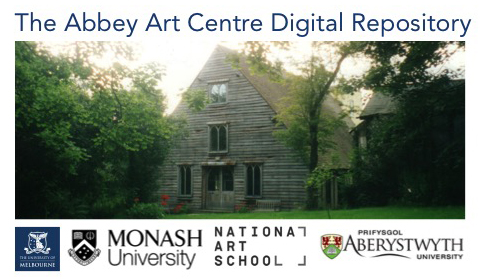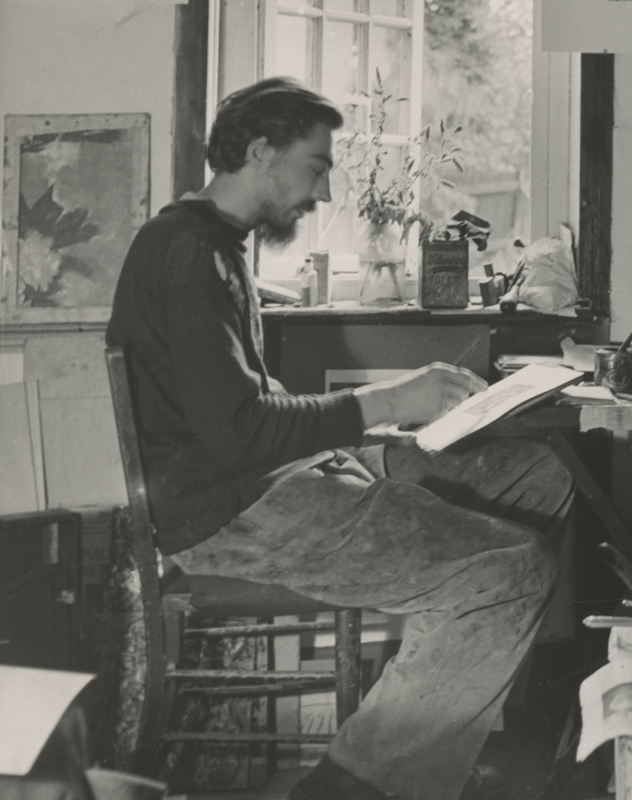Phillip Martin (1927–2014)
Identifier
Title
Type
Relation
Contributor
Birth Date
Birthplace
Death Date
Place of death
Occupation
Biography
Of Irish heritage, Phillip Martin was an artist who believed the image transcended and transformed worldly meaning and materialism. An introverted and only child from a middle-class family, the son of a bank director, Martin spent much of his childhood and young life at the Felsted boarding school in North Essex. When war was declared he spent three years in the national service in the British Navy and in 1948 on discharge, briefly moved back to his family home. When his father caught him drawing in an abstract manner and admonished him for wanting to be an artist, Martin walked out and became estranged from them. Unsure of his direction in life, he entered a Franciscan monastery, but as his spiritual philosophy differed from the brotherhood, he left the order and a period of destitution followed.
Living amongst the Soho poor, he slept rough, ate in refuge centres and wandered the London streets where his loneliness took on a hallucinatory dimension. He discovered a language of beauty and truth in the open streets and, in a city largely ruined from bombing, with its graffitied, scarred walls, discarded detritus, Martin felt that, ‘all phenomena assumed an equal importance in themselves’, and ‘being compelled to use things that other people rejected … [and] living so close to this material in the street, I began to listen to its language and watch its formations’ (Martin, 1961). This close reading of rejected materialism and evidence of peoples’ daily passage, whether a bus ticket, fragment of newsprint, a lolly wrapper, a trodden matchbox, randomly dropped until the strolling fossiker collected and turned it into an aesthetic placard, or a visual symphony of Merzbau, chimed with the collages of exiled avant-garde artist Kurt Schwitters, whose art Martin encountered at this time.
By 1949 Phillip Martin was living at the Abbey Art Centre, New Barnet, an artists’ colony on the outskirts of London. As a cultural hub, the Abbey’s religious, ancient and primitive artefacts provided an environment that traversed national and temporal boundaries within a single location and encouraged cross-cultural dialogues with other resident artists. It was here that Martin established an important friendship with the Scottish artist Alan Davie, whose considerable influence on Martin is evident in his ‘small black and white monotypes and dense tachist, gestural oils’ made during 1949-50 (Jane Eckett, 'Helen Marshall: Return to Beginning', Artist Profile, no. 49, November 2019). Davie had already travelled throughout Europe and seen the first post-war Venice Biennale in 1948, where he met Peggy Guggenheim and was introduced to her major collection of avant-garde art. A strong similarity to Jean Arp’s papier déchirés, or torn paper works is also evident in Martin’s art at this time, which he may have seen in catalogues. The title of one of Martin’s collages, Required: World Interpreter, 1951, captures his existentialist approach, in which he believed ‘the artist has assumed the role of a kind of spiritual archaeologist’ (Philip Martin, letter to Pierre Matisse, Ischia, Italy, September 1954, in Phillip Martin papers, private collection).
While at the Abbey Martin also met the Australian sculptor Robert Klippel and the Berlin sculptor Inge Winter (King), and in 1950 the Irish Australian painter Helen Marshall, with whom he formed a life-long relationship. Martin and Marshall left the Abbey in the spring of 1951, and from March to May lived at Camden Town. They then moved to a disused barge, The Sheila, at Thames Ditton, where they collaborated on paintings and collages. Martin was also included in group shows at Gimpel Fils and the Redfern Gallery, London.
His first paintings were bought by an Austrian painter and admirer of Picasso, Hugo-Damian Schönborn (1916-1979), who went by the title of Count Schönborn. In 1951 Schönborn invited Martin and Marshall to join him and his wife, Eleonore Baroness von Doblhoff, at their castle in Shruns in the Montafon in Vorarlberg, Austria. While staying with Schönborn, September to November 1951, a fire destroyed Martin and Marshall's barge on the Thames. Most of their belongings were lost.
This triggered a nomadic existence for the next decade, as they restlessly travelled between Florence, Venice, Milan and Genoa, often living in impoverished conditions. They settled temporarily at Vence, in southern France, where they exhibited at Galerie Les Mages and were befriended by Marc Chagall, who reportedly advised the gallery owner to purchase the entire exhibition. They made Positano in southern Italy their base but continued travelling to Paris, Bern, Basle, Florence, Majorca, Aix en-Provence, Connemara in Ireland and Zurich.
In Venice, 1954, they were introduced to Peggy Guggenheim at her villa, and in Paris they mingled with some of Europe’s most notable avant-garde artists and writers, establishing firm friendships with the American writer Henry Miller in Paris, the writer Alan Sillitoe in Spain, the French art critic and poet Alain Jouffroy, Roberto Matta, Andre Masson, Karel Appel, Pierre Alechinsky and Mark Tobey.
The decade of the 1950s was significant for Martin and Marshall. In 1952, Michel Tapié included Phillip Martin in his Un Art Autre, a publication on the free-expressive, anti-compositional artists associated with the Art Informel movement, which included Appel, Burri, Dubuffet, Ossorio, Pollock, Riopelle and Tobey. Martin was placed next to Pierre Soulages. Post-war trends in art, such as action painting, art brut, Tachism, with an emphasis on spontaneity, gestural automatism and dynamic spatiality reflected the unsettled state the post-war world as its sought cultural renewal. In 1953 the couple were given a significant exhibition alongside Viera da Silva at the Kunsthalle Bern in Switzerland, and in 1955 Martin began exhibiting at the Pierre Matisse Gallery in New York. In 1956 he was included in a Kunsthalle Basel exhibition Japanische Kalligraphie, alongside Tobey, Miro, Hartung, Klee and Kandinsky, and in 1957 he exhibited at Galerie du Dragon, famous for its support of young poets and artists such as Roberto Matta and Alain Jouffroy.
An aesthetic and spiritual affiliation developed between Martin and Mark Tobey; both artists were extremely reserved and avoided contemporary trends and were drawn together through a mystical approach to the cityscape. Tobey showed work at the 1948 Venice Biennale and in Paris in 1954, when the ‘high tide of tachism’, was flooding galleries throughout Europe (Wieland Schmied, Mark Tobey: A wandering mystic, London: Thames and Hudson, 1966, p. 9). Martin also showed collages at the Galerie Suzanne Bollag in Zurich with Max Ernst, Henri Matisse, L. Moholy-Nagy, Picasso, Schwitters, Viera de Silva, and Sonoia Sekula, and in 1959 was included in a group exhibition at the Galerie Craven in Paris with Arp, Delauney, Dubuffet, Ernst, Kandinsky, Klee, Matta, Mondrian and Schwitters, to name just some.
As is evident from these exhibitions and associations with major cultural figures, the couple were of international significance, yet their constant movement has rendered them invisible to nationalist and global art histories. In 1960 the normally pacifist couple were involved with the Anti-Procés collective in Paris and Milan, a movement organised by Alain Jouffroy and the anarchic Jean-Jaques Lebel in opposition to French military aggression during the Algerian insurrection. Martin exhibited in three separate Anti-Procés exhibitions while, at the Galerie des Quatre Saisons, a manifesto was signed by 121 artists and intellectuals including Martin and Marshall.
As the politicised 1960s progressed, the couple, always ready to pack up and travel, departed in 1962 with their children—Seraphina Martin and Stephen Walton, Helen's youngest child from her first marriage—for India, where they spent the next five years at an ashram in Pondicherry. They returned to London and Europe for exhibitions, including a joint exhibition at the Palais de Beaux Arts in Paris in 1966, and also to Australia, 1969-70, where Helen was reunited with her family who had since emigrated from Ireland. Phillip Martin held an exhibition at Georges Mora’s Tolarno Gallery while in Sydney they both held a critically acclaimed exhibition of over 200 works to inaugurate Gisella Scheinberg’s Holdsworth Gallery. On returning to Italy they spent a productive and settled period of three years at Lake Como.
In 1979, Phillip Martin and Helen Marshall relocated permanently to Glebe in Sydney, though they continued to exhibit regularly in Europe. They held several exhibitions in Sydney, but Phillip found it difficult ‘to penetrate the local art scene’ (St. John Moore). Helen Marshall died in 1996, aged 88, and Phillip Martin devoted much of the next eighteen years to documenting her career before his own death in 2014.
A complex man with a Blakean spiritualism, Phillip Martin found subtle connections and creative narratives in infinite juxtapositions of symbols, an alphabet of signs, and a poetic affirmation of the timelessness of all things. In Martin’s words, ‘It is what is left unsaid that is the mystery of a painting which can only be a substitute for the reality that lies beyond it and that is indefinable and belongs to the realm of magic. It is left to the commentators to dissect the corpse’ (Martin to Pierre Matisse, Ischia, September 1954).
Sheridan Palmer
20 November 2020
Bibliography
Phillip Martin, 'Affiche', X Magazine: Quarterly Review, ed. David Wright and Patrick Swift, vol. 2, no. 2, August 1961, pp. 127-8.
Alain Jouffroy, Phillip Martin: éclatement spirituel de l’Image-Symbole, Paris: Galerie H. Le Gendre, 1963.
Alain Jouffroy, Helen Marshall, Phillip Martin: peintures, collages, gouaches, oeuvres jointes, 1950-1966, Brussells: Palais des beaux-arts de Bruxelles, 14–26 April 1966.
Alain Jouffroy, ‘Phillip Martin et l’illumination’, Quadrum: Association pour la Diffusion Artistique et Culturelle, no. 20, 1966, pp. 103-12.
Alain Jouffroy, Le Cartoline di Phillip Martin, Milan: Edizioni L'Uomo e l'Arte, 1971.
Phillip Martin papers, private collection, Australia.

